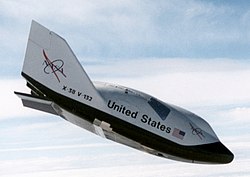
The Crew Return Vehicle (CRV), sometimes referred to as the Assured Crew Return Vehicle (ACRV), was a proposed dedicated lifeboat or escape module for the International Space Station (ISS). A number of different vehicles and designs were considered over two decades – with several flying as developmental test prototypes – but none became operational. Since the arrival of the first permanent crew to the ISS in 2000, the emergency return capability has been fulfilled by Soyuz spacecraft and, more recently, SpaceX's Crew Dragon – each rotated every 6 months.
In the original space station design, emergencies were intended to be dealt with by having a "safe area" on the station that the crew could evacuate to, pending a rescue from a U.S. Space Shuttle. However, the 1986 Space Shuttle Challenger disaster and the subsequent grounding of the shuttle fleet caused station planners to rethink this concept.[1] Planners foresaw the need for a CRV to address three specific scenarios:
- Crew return in case of unavailability of a Space Shuttle or Soyuz capsule;
- Prompt escape from a major time-critical space station emergency;
- Full or partial crew return in case of a medical emergency.[2]
- ^ "NASA ACRV history from Astronautix.com". Archived from the original on September 26, 2007. Retrieved November 7, 2006.
- ^ Stepaniak, Philip, MD; Hamilton, Glenn; Stizza, Denis; Garrison, Richard; Gerstner, David (July 2001). "Considerations for Medical Transport From the Space Station via an Assured Crew Return Vehicle (ACRV)" (PDF). Johnson Space Center. NASA. Archived from the original (PDF) on October 5, 2006. Retrieved November 6, 2006.
{{cite web}}: CS1 maint: multiple names: authors list (link)